Brand Development, Web Design, and Google Analytics Specialists
Experienced in SEM, SEO, Social Media, and Traditional Media
How to Create Quality Blog Posts

Are you looking for a better way to attract more customers with more interesting blog post ideas? Sure, you are! Every savvy business owner is. After all, a great blog post could be the difference in success and failure.
Blogging is a great way to drive traffic to your website, keep your target audience there longer, and attract new customers. By maximizing search engine optimization (SEO) through user-generated content and ensuring interesting post ideas, it’s also a way to expand your audience. People don’t usually share ads with their friends, which limits your potential for reaching people who aren’t already following you.
It’s fun, too. But not everyone is a natural writer. Even the best ideas can fall flat if they’re not presented in an entertaining fashion. On the other hand, a well-written blog post can make even the dullest subject interesting enough to read about.
Here’s how to craft a blog post with quality content that’s not only fun to read, but also drives traffic to your business. After all, content is everything and writing blog posts with good content creation should be fun—just ask any successful blogger.
Research your keywords
To begin with, you’ll want to find out what your customers are looking for. In the days of old, ad companies got paid millions of dollars just to figure this out. Nowadays, that information is just a few keystrokes away. Add the right blog content and you are away.
Online services like Ahrefs and Moz can tell you everything you need to know for only a few dollars a month. They do this by tracking what people are searching for online. For example, if you type “electrician” into one of these sites, they’ll tell you all the words people are using along with “electrician.”
You’ll get a list with terms like “cheap electrician,” “master electrician,” “licensed electrician” and “electrician near me.” If you use these popular search terms in your post, people will be more likely to find it.
Choose a relevant topic
Now that you know what your audience is searching for, you’ll need to choose a topic and blog content they’re interested in. Returning to our electrician example, we could choose a topic that’s relevant to several of those keywords.
For example, we might write an article on “How to Find a Cheap, Licensed Electrician Near Me.” That article could include the keywords “cheap electrician,” “licensed electrician” and “electrician near me” several times throughout the text.
By choosing a relevant topic, you’re not just finding a way to use lots of keywords. You’re also writing about something your audience actually cares about, which means they’re more likely to read the entire post.
Don’t over-optimize
Whether on social media or looking at online blogs, once you’ve learned the importance of keywords and how to find them, it can be tempting to insert them everywhere in your post. To show why this is a bad idea, here’s an example of an over-optimized paragraph:
If you’re looking for a cheap electrician, you can find a master electrician for cheap on our site. Whether you’re looking for a licensed electrician for interior work, or a qualified electrician for commercial work, you’ll find one. If you’ve ever asked yourself “How do I find an electrician near me?” we’ll show you how to get the best electricians in your area.
Sure, that paragraph is full of keywords. But it also sounds awful. Even if the rest of the article is full of great tips, nobody’s going to keep reading.
Use keywords, but use them naturally. Less is more, especially when it comes to making your blog post readable.
Begin with a hook
When you’re writing a blog, you’re writing on the internet. People have short attention spans, and the next blog is just one click away.
So how do you keep their attention?
Give them a reason to keep reading. You’ll want to address their needs in the first sentence or the first paragraph at a bare minimum. For example, if you’re writing a post about finding a cheap electrician, you might start with something like this:
Do you need electrical work done on a budget? Do you need to fix a safety issue or add an outlet without breaking the bank?
That’s not exactly perfect, but it addresses your customers’ needs. They’ll read that, nod their heads and keep reading. Now, they’ve committed to reading your post.
Use short paragraphs, subheadings and bullets
If you’re used to reading novels or technical writing, you’re probably used to long paragraphs. There’s nothing wrong with long paragraphs, either. Sometimes, good writing requires them.
But, again, we come back to the fact that this is the internet. Huge blocks of text look boring and people start skimming instead of reading. How do you avoid this?
Leave plenty of white space on the screen. Ideally, paragraphs should be four lines or shorter. They can even be a single sentence—if you want to emphasize something.
Another way to add white space is to use subheadings. Ideally, you’ll want to insert a new subheading every 100–300 words. This makes the article feel shorter and people feel like they’re making progress while they’re reading.
If you have a subheading that requires a lot of words, you can change things up by adding a bulleted list. This adds more white space and makes the subheading feel shorter.
End with a call to action
Finally, you’ll want to connect the blog back to your business. After all, the ultimate goal is to attract customers. To do this, you’ll need to incorporate what marketers call a call to action. Basically, you need to specifically ask people for their business.
Salespeople will be familiar with this technique because they do it in person all the time. It’s called “asking for the sale” and it’s something every salesperson learns in Sales 101.
You’ll also want to include a link in your call to action. Why? Because people have short attention spans. Even if you’ve convinced them they need your services, they’re less likely to do so if they have to open another browser tab to Google your website.
The next thing you know, they’ve become distracted by some cute cat pictures and you’ve lost a customer.
If all else fails, hire an agency
For some people, this may seem daunting. Even if it sounds entirely doable, your time may be more useful elsewhere, like meeting with clients or managing your business.
If that sounds like you, consider hiring a marketing agency like Above The Fold to help create your blog content today. Contact us today to receive a free consultation.
7 Simple Strategies To Get The Most From Yelp

Independent review sites are a great move for any business, providing that is, you manage your presence online and garner a following that helps your business to be pushed up the rankings.
Yelp, along with other search-service websites, has revolutionized the way customers search and interact with businesses. From restaurants to cafes, to car mechanics and artisan food producers, Yelp can be a fantastic marketing tool for businesses in San Diego, and indeed, anywhere else in the world.
With 130 million unique visits a month, it pays to understand how harnessing the power of Yelp will help your business.
#1 Quality speaks
Quality service is something that we all look for in a business and when this exceeds what we were expecting as customers, we are usually more than happy to tell others.
Of course, just as people love what you do, there will be some customers who don’t love what you do.
This customer review culture may appear scary, but it can be the catalyst for reviewing and improving the services and products that you have on offer. We also have to remember that customers are intelligent creatures and they can see through ‘one person having a gripe’ as opposed to the whole business being bad.
Having said that, if the complaints are about the same thing, maybe there is something that you need to change.
#2 Create a fantastic Yelp profile
How many business profiles have you created for apps and third-party websites? And here we are, asking for another one on Yelp.
However, if you are serious about harnessing the power of Yelp for San Diego business visibility – remember those 130 million unique searches a month! – then creating an interesting business profile on the website is fairly critical.
This says a lot to potential customers too. The platform gives you plenty of tools and suggestions on how to create a business profile that shines the best spotlight on what you do.
#3 Encourage your customers to use Yelp
Just like we see suggestions in store to like what a business does on other platforms, like Facebook, you should be encouraging people to leave a review on Yelp.
There are occasional scandals with brands paying customers or writers to leave reviews so that it pushes up their review score. While this is dancing on the edge of moral and legal responsibility, there is nothing wrong with encouraging reviews from genuine customers.
#4 Getting the balance
We mentioned earlier that not everyone will love what you do. Giving a business in San Diego a good bashing is all in a day’s work for some customers, therefore, it is no surprise that many businesses have concerns about ratings and reviews on third-party review sites and other platforms.
Here’s the kicker – the more positive reviews you have, the less of an impact an occasional bad review will make. Let’s be honest – stuff happens – and sometimes, people don’t get the best.
The important thing is understanding how to handle this at the time but also how to handle a poor review online. But like we said, if you have plenty of genuine, good reviews, your rating won’t plummet to the bottom of the cliff if someone leaves a poor review of your business.
#5 Don’t be tempted to buy reviews
The temptation is strong but you must resist simply because Yelp has an algorithm that detects fake reviews for San Diego businesses. In fact, one in five reviews is detected as fake, although this algorithm is not perfect. Genuine reviews have been filtered out of the search.
Yelp is also looking at other ways of detecting fake reviewers and although you may want to build your reputation on Yelp, fake or bought reviews is NOT a worthwhile strategy.
#6 Engage and connect with customers
The thing with reviews is that many, many customers take the time to leave a review expecting nothing to happen.
However, we all see the outcome when someone leaves a bad review and the business responds with kind or hilarious reply. But what about when customers leave a complimentary review? What happens?
Yelp and other similar platforms are built on interaction and that means that every San Diego business needs to interact with their customers on the platform. Effectively, you can encourage people to use yelp in San Diego and your business can use it as an open forum for discussion.
As well as reviews so other customers can assess whether they want to buy from you or not, Yelp is a great listening tool as well. What is it that customers are asking for or expecting? Can you change your business to answer their need? Do your products or services need updating?
#7 Use the platform to its full advantage
Yelp offers businesses a range of features that once you understand how they work, you can use to your full advantage.
For example, Yelp Deals is a prepaid voucher system that gives customers discounts off your products and services. For example, a customer may buy a voucher for $10 but the customer redeems it for $20.
Yelp Reservations is another tool that can help restaurants and cafes, ideal for easy reservation services for customers.
More Information On Getting Yelp Reviews For Your Business
Word of mouth is an effective marketing tool and always has been, hard to believe in the digital age. However, platforms like Yelp are transforming this word of mouth into something that can be harnessed online.
Review sites can be both a blessing and a curse. On one hand, you can use your happy customers to spread the word about who you are and what you do. But on the other, a poor review or a series of bad reviews can create difficult conditions in which to trade.
That said, a business with a forward-thinking attitude will look at these reviews objectively, using them as a platform from which to grow their business.
Getting it right also means engaging and connecting with customers. From responding to a poor review to entering into discussion with fans and followers, Yelp is just one platform you can use to push your business forward in the online world.
Speak With Above The Fold Agency Today
If you are looking for a digital marketing agency in San Diego to help you increase your online presence, the team at Above The Fold Agency is here to help. Contact us today to receive a free consultation.
5 Reasons Your Business Needs Email Marketing Today

Before the advent of apps, every brand curated a database of contacts and customers, sending out timely reminders to buy products or to try the latest product on the shelf. The problem was, some brands sent emails out thick and fast. Customers began to tire of having a full inbox and with apps bursting onto the scene, many of us moved our attention to these. But then these became an issue too or more accurately, the notifications from apps started to clutter the screen.
Email marketing in San Diego and across the US seems to have risen once again from the ashes. Even though there are many other forms of digital marketing for San Diego businesses, it seems that in 2018, email marketing is back, bigger and stronger than before. Why bother with email marketing? No matter how big or small your business or the sector or industry you dominate, email marketing is a great vehicle for reaching out and connecting with customers.

Digital marketing is nothing new. As soon as the web sprung into life, those with a forward-thinking habit realized that the Internet would become a place ripe for reaching and engaging with new and returning customers in San Diego and beyond.
But it is an increasingly busy and crowded place. Trying to make headway into the busy world of the web can seem like throwing your marketing budget into the wind. While email was once considered an old form of marketing, it now seems that it is back in fashion, so we have the top 5 reasons why you should start email marketing (again)!:
#1 Improved return on investment
In marketing, it’s all about ROI. Essentially, for every dollar of the marketing budget you spend, you want a profitable return in the shape of a buying customer. Marketing is an investment and you need it to produce an outcome so that your business remains a thriving success. The less you spend on reaching customers, the better in most cases.
Can you get cheaper than email? We think not. There are no postage fees, no advertising fees, no mobile app charges, no printing costs and providing you stay on the right side of GDPR and the rules relating spam emails, you will find that for very little cost, you get a fabulous return on investment.
Depending on where you find your statistics, for every $1 spent on email marketing, the ROI is around $32.28. Now, who could afford to turn that down?
HINT: The email copy needs to be well written and fitting with your brand. It needs to also be written in such a way as to stand out in a crowded inbox.
#2 Emails are easily sharable
Many of us have discovered, much to our embarrassment, just how easy emails can be to share, albeit with the wrong group of people on occasion. But sticking with this shareability for a minute, the reason why email marketing is enjoying a resurgence is because it is a medium that is easily sharable without too much fuss.
When your email message and content resonate with the recipient, they are more likely to share it. There are an estimated 124 billion business emails sent every day, with personal emails only figuring slightly less at 111 billion a day. This vibrant display of sharing could be something your email marketing benefits from.
#3 Easy to create
Dependent on your skills and abilities, the most successful of marketing emails, (those that are opened, read and acted on) are;
- Well-written: excellent email copy is one that resonates with the subscriber, tells them everything they need to know in the right tone of voice.
- Call to action: an email that is successful will not only have strong content but a strong call to action.
- Visually appealing: a lot of information can be included in an email which is why sometimes they can look crowded and fussy. Images are perfect for use in email marketing providing they support the message being sent.
- Driven by strategy: throwing out an email or two every now and then and hoping for an increase in customers will work only with chance and luck on its side. To create your own criteria for a successful email campaign, it needs to be driven by a clearly defined strategy.
#4 Measurable
Using an email marketing tool as a San Diego business allows you to access a set of metrics from people opening the email you’ve sent. Metrics include clicking on links, subscribers to unsubscribes, the number of emails that bounced and so on.
This analysis is essential and not something that is available with other forms of marketing. How many direct mail campaigns, for example, end up in the recycling, unread and unopened?
An understanding of these deeper metrics will allow you to produce a more balanced, strategized approach to future email marketing campaigns. In other words, you have the date on which you can make better decisions so results are maximized and objectives achieved.
#5 Personalized marketing
At one time, emails would be sent to everyone and everybody. But there was a problem with this anonymous, impersonalized approach alienated many people. Inboxes became cluttered and some emails became a nuisance. Personalization doesn’t just mean putting someone’s name at the top of the message. It means you have the ability to send certain emails with offers and discounts on products that you know they like to a group of customers and a different, tailored email to another group.
Are You Ready to Start Email Marketing?
Email marketing has made a strong comeback, but you need to be entirely confident in how it can and should work to get the results that you need. You can craft an email that is useful and personal, you can measure its impact, it can be shared quickly and easily, and get the content right, and the success of an email marketing campaign can fly. If you are looking for a digital marketing agency in San Diego to help you increase your online presence, the team at Above The Fold Agency is here to help. Contact us today for a free consultation.
Databox: How to Track Your Social Results

As a marketer, analytics and data is a huge part of my life. I am constantly searching for consistencies and patterns, and adjusting along the way when things aren’t trending in directions I would like for my clients. Making these changes requires a lot of data research, and I have been using this website Databox.com to gather the numbers, and organize reports so that I can easily see social media metrics and progress daily.
How does Databox work?
Databox pulls all your data into one place, so you can track performance and insights on your business, marketing, and/or sales all in one place in real-time. Once you create an account on Databox.com, Databox then brings you to a page that includes over 65 different integrations including Google Analytics, Hub Spot, LinkedIn, Facebook, and Twitter. Those are just a few of the most popular. Linking your accounts is easy. You simply click which account you’d like to link, and then login to that account and approve the connection. Once you link the social accounts that you want to measure to Databox, they show up on your home screen as soon as you login. You also always have the option to add on more accounts as you go.
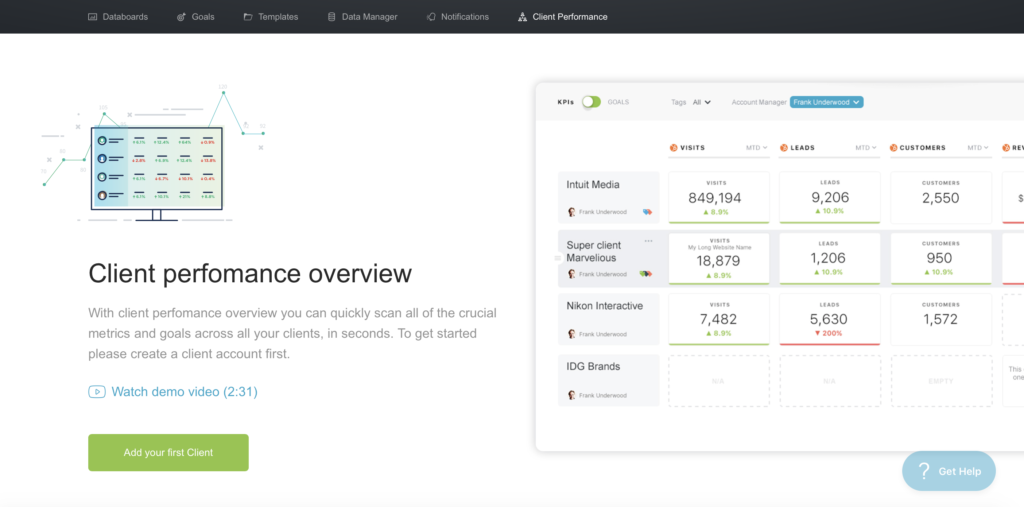
Advantages of Databox
The home page gives you 5 different tabs that allow you to take advantage of the usefulness of Databox.
• The option to set and track your goals for yourself, your business, or your team. You have the ability to set time-bound numeric goals and track your progress on these personalized goals.
• The option to change the template of your accounts to your liking.
• The option to manage account data.
• The option to view notifications (scorecards and alerts).
• And the option to add clients for overview performance so you can quickly scan your goals and metrics across all clients.
These options allow you to customize each client’s reports, and manage the data easily and quickly. If a client has a specific need or wants to see different metrics, I can easily switch things out on the home page and make new reports based on the new settings.

Databox Data Board Tab
On the data board tab, where you have access to your accounts- on the right side you are able to see your setup progress, and what you have left to do in order to become a registered partner (level one). This unlocks many benefits including being listed in the Databox partner directory, increased exposure from features in Databox, self-service email support, and the ability to vote in new features and integrations. Once you unlock level one, there are two more levels: Certified Partner, and Premier Partner. Each level gives you access to more and more benefits. Even without these benefits the site still helps you see your growth and progress without having to login to every social account separately and look at each post and like and engagement. On the data board tab, you are also able to access a ton of information on your accounts. You can customize the information that you want the ability to view.

Databox Data Points
Databox has tons of valuable information right on the home page for you to click and look at visually. Things like LinkedIn followers, Facebook page likes, and Twitter followers were some of the most popular that I chose for the first client I plugged into the software, but there are different metrics based on the various social channels you plug in. Every metric is customizable, so it depends on you to decide what is most important to you when you are looking at your goals and matching them up to the results you get with the software tracking.
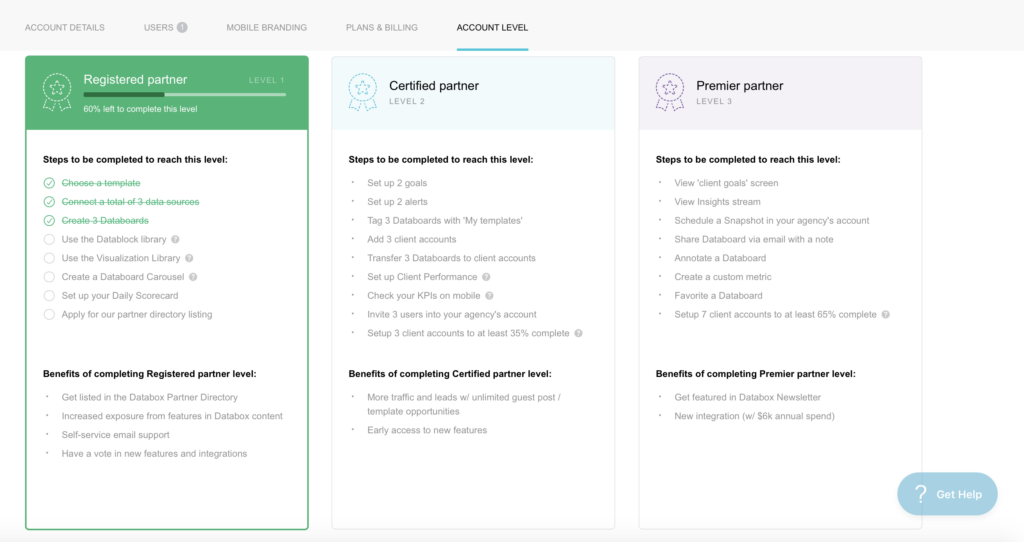
Overall
Databox is extremely helpful because it allows you to manage multiple accounts at once and provides important metrics that provides you with helpful information to grow and drive traffic to your accounts. It helps you identify what is working and what isn’t. It helps me provide my clients the information they need to make the best educated decisions for their business and brand. If you’re looking for a great software to use to gain insights into your social progress, try Databox today.
6 Tips To Create Content Marketing Plan For SMBs

As a business in San Diego, you will create content, all in the hope that it will grow your business online. But a content marketing starter plan removes the word ‘hope’ to drive your business forward. Below are 6 tips to create a content marketing plan for your small business:
Tip 1 – WHY are you creating content?
Most San Diego businesses being asked this question are probably unsure as to the real reason why they are creating content. There’s no clear direction or strategy and that’s a problem.
Content needs to be of high-quality. It needs to be relevant to your audience. It needs to be informative and not overstuffed with keywords and phrases, and so not created to entice people to buy.
Tip 2 – Setting goals for your content
You will want the content you create to accomplish goals for your business. Here are some common themes to content creation by other San Diego businesses;
- Raising/maintaining brand awareness – a buzz around your business means customers return and new ones find you. It is your chance to show people who and what you are.
- Provide value – some businesses and organizations take the opportunity to add value to their services with quality content. ‘How to’ articles and videos, for example, are useful and valued by customers.
- Earn traffic – links that are genuine and content that answer search questions boost your website rankings.
- Acquire more leads – when people find content, they can be asked to join an e-mailing list and this in itself can swell your customer numbers.
- Build community and connections – the online world doesn’t have to be disconnected and anonymous. Content can build an enthusiastic and thriving fan base.
- Promotion – content promotes your business in many ways but specific content can be created to promote something specific
Tip 3 – Create content for your audience
Many years ago, content wasn’t created for readers or customers but for search engines. Short pieces of content were rammed full of keywords in their extract format. Many articles and blog posts made very little sense in terms of language, grammar or how helpful it was to the customers.
This has changed and yet, so many businesses still don’t create content for their customer demographic.
The next time you load a blog post or spend dollars on creating a video, ask yourself is this what my customer wants?
What is it that your customer wants or needs to know? What is the best format to put this in – is it a blog, a how-to guide, a downloadable set of instructions or a video… or all of these things?
You may also find that what you produce, how and when changes based on the type of business you operate.
Tip 4 – Vary the content
In some ways, these tips are steps to a creating a content marketing strategy and we are now at the stage of deciding what format the information will be delivered.
- TOPICS – topics can be many and varied but providing they have a connection with your business, products or service, they could prove invaluable to your customer. What questions are your customers asking? What are they talking about on social media?
- KEYWORD ANALYSIS – this allows you to see what search terms and questions customers are using to search for products or services like yours. By using this key phrase in your posts, you will push yourself up the rankings.
- COMPETITORS – don’t copy what your competitors are doing but it is worth looking at their blog and so on to see what direction they are taking. But consider what they are missing too? Is there a gap that you could fill?
- FORMAT – what format works best for your customer? There is a growing range of content-vehicles from podcasts, videos, blogs, guest blogging, white papers, newsletters, downloadable guides…
Tip 5 – How will content be distributed?
It’s a sad fact that there is a wealth of amazing content out there that no one has seen, no one has viewed and no one has read.
Why you may ask?
Because most small businesses aren’t taking the right steps to amplify their content. They need to be commenting on other blogs, posting to social media, and building the right buzz to get people to talk about the amazing content they create.
If you aren’t familiar with the digital marketing strategy of Outreach, we recommend you read about it to see the value it can bring to helping distribute your content.
Tip 6 – How will you measure success?
Are people finding the content? Are they commenting on it? In other words, how will you measure the success of what you are producing?
Think back to Tip 2 when we talked about setting goals. In effect, measuring the success of your content means answering the question of has it boosted brand awareness? Or has it earned more traffic to your site?
But more importantly, if you have a plan and a strategy fueling it, content will create a return on investment for your business. You just need o track it to make sure it’s successful.
Speak With Our Team Today
If you have questions about SEO for your small business, speak with our team of experts today. We’d love to learn more about your business and offer a free consultation. Click here to get started today!
Top 10 Marketing Tactics for 2018

In our society today, we have seen a large shift into digital and social media marketing. Although many of us will look up on our way to work and see a large billboard that is semi clever, most of the products and services that attract us will be found through tv and social media. Today we are going to discuss 10 of our favorite and most popular marketing tactics to use this year.
1. Undercover Marketing
This is one of our favorite types of marketing, however it does not get enough use. Actors will be placed in a public area using the product, and people standing by will be intrigued to ask what it is. Once they do that, the actor will allow them to try it out and provide information. Undercover marketing is stealthy and noninvasive, however reels customers into buying a product. For example, when Sony Ericsson had actors pose as tourists, asking people to take a picture of them so that they could see for themselves the amazing new picture phone.
2. Social Media Influencer/Brand Ambassador
This form of marketing has been the most up and coming this year. Companies will reach out to Instagram/twitter/snapchat users with a large following and pay them or offer them a discount on their product to give them “shoutouts”. Social Media influencers will post pictures/videos of them using the product and recommend them to their followers. A lot of the time, Influencers are given a discount code to share with their followers as well which is even more attractive.
3. Product Placement
Product placement might seem obvious to some consumers; however, it is an effective marketing tactic. Product placement is when companies pay to have their products featured in certain movies or TV shows. Product placement can go from a shirt a celebrity is wearing in a movie, to the drink they have in their hand, to what brand laptop that they are typing on. A lot of times it is sneaky how the product is placed, but even if the consumer may not notice it it will still be in the back of their minds. Sometimes, product placement doesn’t even have to show the actual product, but it can be part of a conversation within the dialogue of a movie/tv show.
4. Newsletter
This is a smart tactic to keep your consumers attention. When a customer buys your product, give them the option to sign up for emails that include special offers, this way you will be able to keep your consumer updated with deals and updates, while keeping their attention on your product/service.
5. Guest Blogging
Although providing content for your product or service on your own output creates attention, it is also important to show up on other outlets as well. Doing this helps grow your consumer market by introducing your product/service to a new audience that may not have stumbled upon it otherwise.
6. Positive Reviews/References
Creating a yelp page or having a system where customers can rate your product/service after buying, makes a large difference in future success. Many people will look towards previous customer reviews before making a purchase as their deciding factor on the product/service. This also leads into buzz marketing, or word-of-mouth marketing, where customers will speak of your product to their family or friends, and this trend will continue.
7. Content Marketing
Content marketing is a smart way to indirectly sell your product/service. It provides the consumer with information and education, and shares material that relates to your brand rather than directly advertises it. This engages your target market because it allows them to make their own choice with the information available, and also builds your brands respect and credibility.
8. SEO
Search Engine Optimization is a learned task that will take time and effort. You cannot do it once and expect results. However, once you have perfected this skill specifically to your marketing efforts, it will work very effectively in your favor. The visibility of your site among others will be much more readily available, and you will learn how to better write/post content that attracts more viewers.
9. Use Social Media Analytics Tools
Our favorite tools to use are BuzzSumo and Sprout Social. These tools help you identify what of your content is doing well and what you should continue to do. It communicates with customers and measures how successful your marketing efforts are.
10. TAKE ADVANTAGE OF SOCIAL MEDIA PLATFORMS!!
There are so many social media platforms out there that are readily available to use and take advantage of. Each platform does better at certain things. For example, Instagram is best for photo content. LinkedIn, Instagram, Facebook, Twitter, Youtube, and Snapchat are all free applications that will only serve to benefit your product/service marketing efforts.
We hope that this article will be helpful and help you succeed in your marketing efforts. Let us know what you liked best or what you saw truly make a positive difference in your success!
10 Podcasts that Will Ignite Your Entrepreneurial Spirit

Podcasts are increasingly becoming a part of our daily habit. No other platform allows audiences to consume educational content while completing other tasks. Marketers, business owners, and entrepreneurs strive to become greater experts in their fields, and podcasts give them the ability to develop professionally even during their daily commute.
We’ve sifted through the endless marketing, business minded, and self-development podcasts to give you the 10 very best. Each podcast dives into varying arenas of the business world. All sure to provide nuggets you can take with you into your personal and professional life.
Let the boost in productivity and inspiration begin!
1. Gary Vee Audio Experience
An amalgamation of the million different podcasts and audio content Gary Vaynerchuk seems to produce these days can all be found in the Gary Vee Audio Experience. Gary believes the future is voice and audio, and so you can expect full throttle, epic content to inspire your work day and motivate you to launch your dream business you once thought impossible. Prepare yourself for unapologetic straight talk when it comes to his thoughts, interviews, and business advice.
2. Social Media Examiner
The Social Media Marketing Podcast is a top-10 marketing podcast hosted by Michael Stelzner and fellow members of the SME team. Episodes feature success stories and expert interviews from industry leaders to help listeners learn new strategies, and actionable tips to improve their social media marketing. Delivered in 45 min digestible weekly episodes every Friday, it’s your go-to for everything Facebook, Twitter, Instagram, and beyond.
3. Smart Passive Income
Who doesn’t relish the idea of making money while you sleep? This is the core concept behind passive income. Of course, there’s plenty of work to be done upfront to get your business soaring, and this is where Pat Flynn steps in. His weekly podcast provides his audience with life-changing strategies and advice for building your online business. Often he interviews business men and women who share their own stories of failure and success.
4. The Joe Rogan Experience
While Joe Rogan is best known for his stand-up comedy and stint as Fear Factor host, he’s also one of the original podcasters that propelled the platform into the colossus that it is today. We included Rogan because of the breadth of guests he interviews on his show. They range from entrepreneurs, musicians, actors, activists, viral sensations, MMA fighters, to political juggernauts. Each with their own knowledge to impart and stories of struggle and triumph to inspire your own journey.
5. The Tim Ferriss Show
As one of the most prolific marketing and business podcasts on the airwaves, The Tim Ferriss Show has consistently been the #1 business podcast on all of iTunes, and has regularly ranked #1 overall amongst 300,000+ podcasts. Each long-form and content packed episode features world-class performers, entrepreneurs, and business leaders to extract the precise tactics, tools, and routines they use so you can adopt into your own life. It’s definitely a can’t-be-missed listening experience.
6. Online Marketing Made Easy
If you’re a small business then you have to listen to Amy Porterfield’s Online Marketing Made Easy. She outlines various marketing strategies by breaking them down into manageable, step-by-step pieces. Ensuring she’s fulfilling her mission to make everything as actionable and profitable as possible. Not only does she provide marketing guides, but also killer expert interviews and intimate behind-the-scene secrets from her biggest launches.
7. The Turnaround – The Growth Show
Half of all businesses fail after five years, and only a third make it to 10. Produced by Hubspot, The Turnaround/Growth Show is a podcast highlighting companies that nearly closed up shop, and instead embarked in a stellar turnaround. Making it a great show for any business struggling with how to grow effectively.
8. The School of Greatness
Hosted by entrepreneur and internet guru, Lewis Howes, The School of Greatness is dedicated to sharing inspiring stories from the most brilliant business minds, world class athletes, and influential celebrities to discover what makes people great. Prepare to self-analyze and feel tested. Both of which will lead to self-growth and success.
9. The Broad Experience
The Broad Experience is a 20 minute podcast conversation about women, the workplace, and success. Hosted by Ashley Milne-Tyte explores everything from race and class to being a professional woman without kids, the difficulty of delegating, and sexual harassment. Outlets like Fortune, Gawker, The New York Times, The Economist, The Guardian and more have praised the show for its storytelling and intelligent discussions.
10. Entrepreneurs on Fire
John Lee Dumas has taken the term “content creator” to the next level. His podcast, Entrepreneurs on Fire (EOF), interviews inspiring and successful entrepreneurs 7 days a week! Everyday you’ll hear from featured guests describing their worst entrepreneurial moments, their AH-HA moments, and what’s working for them in business right now. Over 1,900 interviews have been published with guests ranging from Tony Robbins, Seth Godin, Gary Vee, Barbara Corcoran, and many more.
27 Free Marketing Tools that Actually Grow Your Business
When performing a simple search for a variety of marketing tools you’re sure to churn out what seems like a billion options. After going through a few in each category it can feel like you really can’t go wrong with any of the tools. Especially when they’re lauded with endless reviews from Fortune 500 companies or the most relevant marketing guru.
What’s more, many of the available marketing tools come with a hefty price tag that just isn’t feasible quite yet for startups or small businesses.
Thankfully we’ve removed much of the guess work and analyzed dozens upon dozens of tools, all with the price tag of $0 so you’ll know straight away what to invest your time building into your marketing strategy.
Social Media Scheduling
1. Later: If you’re using Instagram heavily for your business’ products and/or services then you need Later in your life.
With capabilities like visually planning and scheduling 30 posts monthly, all of your workflow is kept in one super organized place. The Visual Instagram Planner enables you to flawlessly curate the layout of your feed (our favorite feature)!
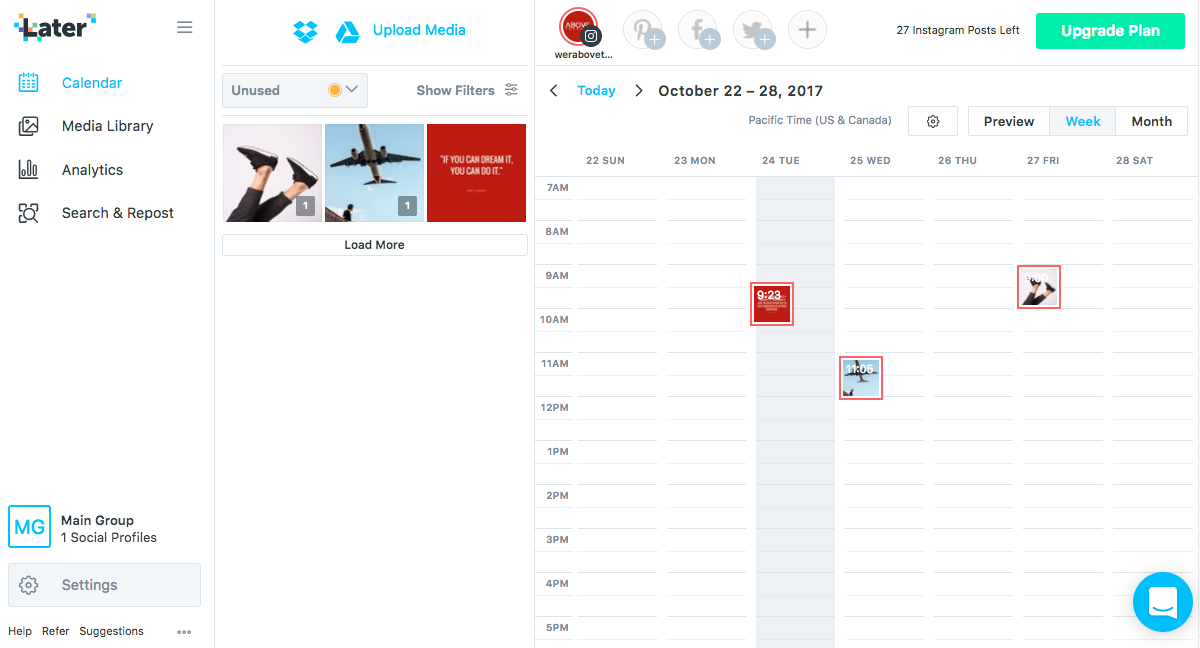
If you’re able to upgrade to pro then you’ll be able to utilize Linkin.bio, which gives you the capability of having multiple links in your bio. Additionally, pro allows you to post across Facebook, Twitter, and Pinterest.
Don’t want to pay for the Linkin.bio feature? Then Linktree is an awesome and FREE alternative.
Other great options:
- Buffer: The forever free plan lets you connect one profile from Facebook and Twitter, and schedule ahead 10 posts for each network. Meaning, if you share three posts per day you can stay three days ahead all the time.
- UNUM: Another great way to plan the look and feel of your Instagram feed. While also gaining simple analytical insights into the performance of your posts. You’re only allowed up to a certain number of planned posts before you have to upgrade.
Hashtagging
We’ve all been there… staring blankly at our phones after copying and pasting our usual hashtags. Wondering if there are any other ones out there that can serve us better. Or maybe you’ve struggled with the infamous shadow ban. The following tools will help you on both fronts.
2. Display Purposes: With Display Purposes you can discover related hashtags three different ways: through search, localized map, and graph. Just enter the hashtag you generally utilize and watch as the magic happens.

3. Focalmark: This app for iOS and Android operates similarly by allowing you to search and find related hashtags. Since it’s app based you’re able to seamlessly copy and paste to Instagram.
4. Shadowban: Test your recent posts to see if the hashtags you’re using are getting you banned from being discovered. Probably one of the most useful tools out right now!
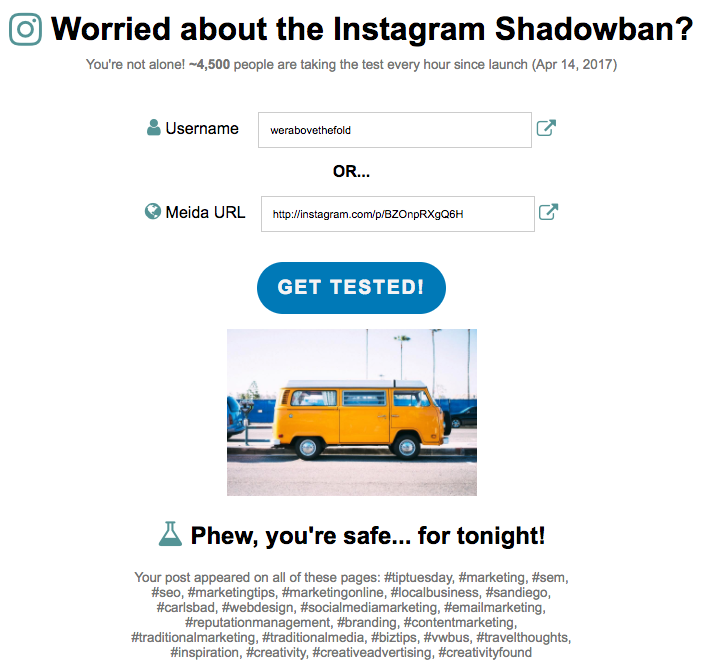
Free Images
4. Unsplash: One of the most robust and beautifully curated free image sources on the Internet. With pictures being added daily you can easily find the perfect capture for your next marketing campaign, social, or blog post.
We use Unsplash often for imagery used in our blogs post and social.

5. Pexels: Another great source for free stock photos.
Photo Editing
6. ColorStory: Eye popping color and beautifully crafted presets with robust editing tools.

7. VSCO: One of the world’s go-to photo editing apps. We love using them as part of the overall editing process.
Other Paid Option:
- Afterlight: Another great editing app if you’re looking to get more granular with your edits, instead of relying only on filters and gimmicks.
Design
8. Canva: Over 2 million people use Canva to create stunning images for social media, blog posts, Facebook ads, landing pages, and so much more.
It’s a wonderful resource for businesses with limited design budgets or even know-how. The optimized sizes and templates make it easy to develop content for every social platform in a really imaginative a deceptively skillful way.
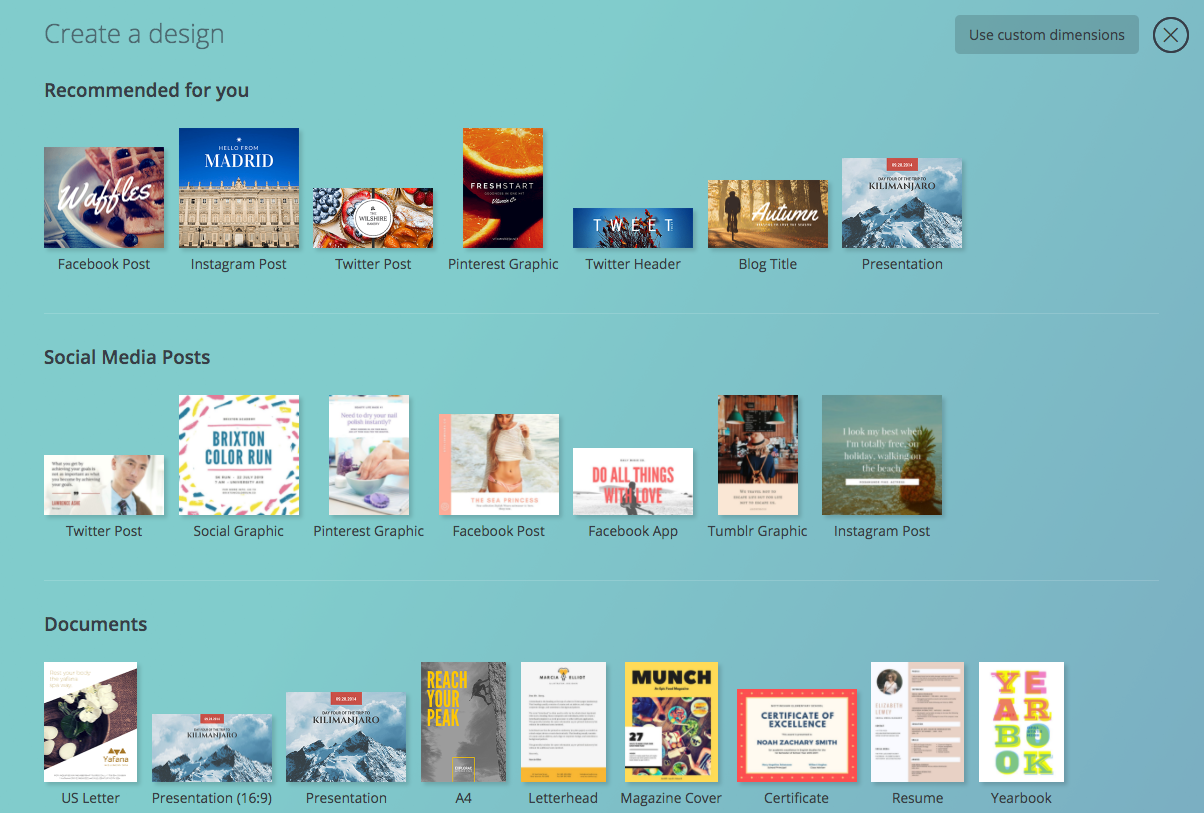
Influencer Marketing Related
9. Influencer Money Calculator: Every wonder how much a particular influencer is really worth or if you’re over spending on your influencer marketing campaigns?
Then head over to Influencer Marketing Hub’s money calculator, which provides an estimate on how much to pay influencers for a campaign.

10. Klout: By using social media analytics to rate its users according to online social influence via the Klout Score, they’re able to place a numerical value between 1 and 100 on an influencer. Use Klout as part of your influencer selection process.
Generating Content Ideas
11. Buzzsumo: Whether in a blog post idea drought or trying to gage what content performs best for a specific topic, Buzzsumo is your place to figure it all out.
They allow a few searches for free, but afterwards will require an upgrade to pro so we suggest a targeted search if you can’t afford the service quite yet.
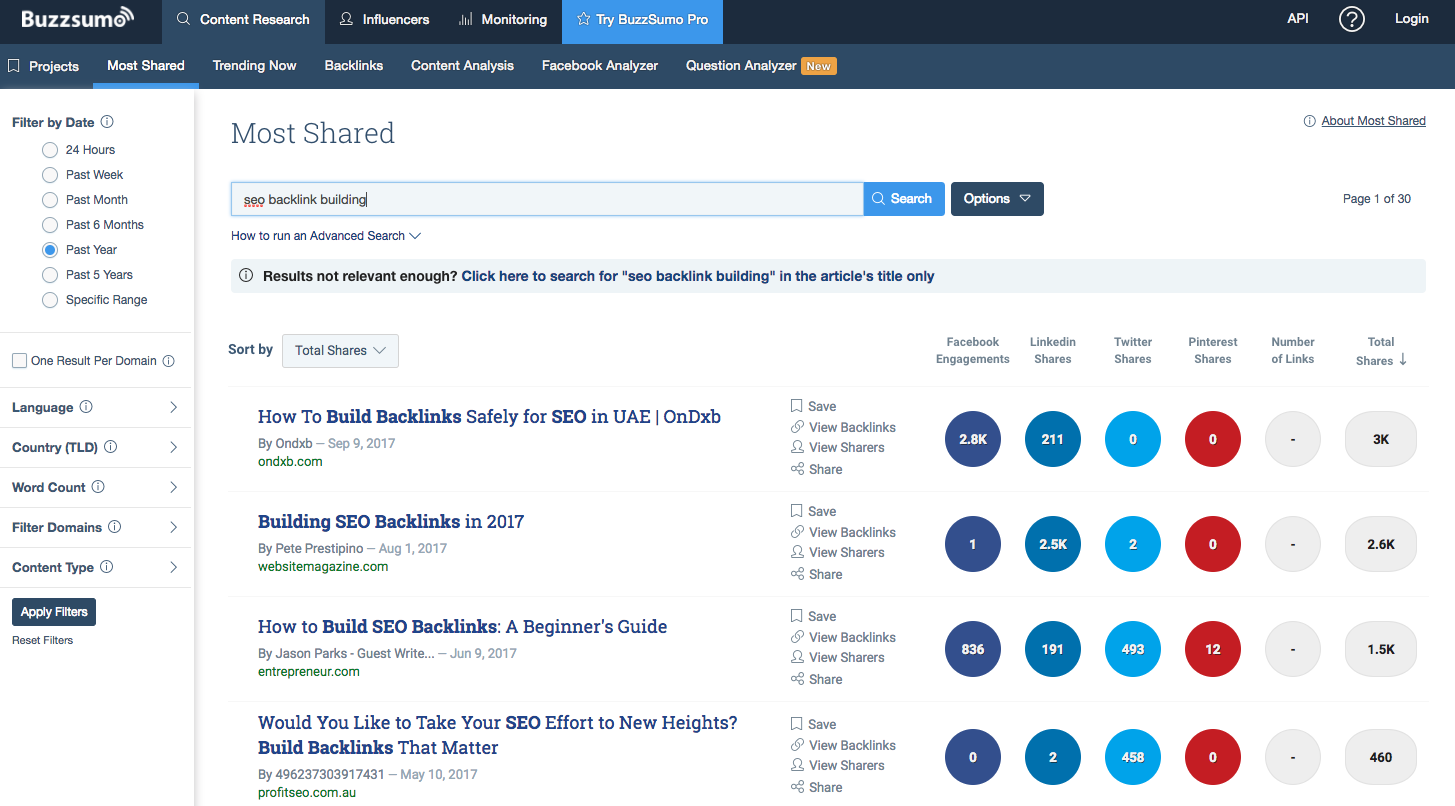
12. Ubersuggest: Use Ubersuggest to quickly find new keywords not available in the Google Keyword Planner. You’ll uncover tons of keyword ideas for SEO, PPC, and content marketing campaigns.
Landing Pages
13. WordPress: If you’re already using WordPress for your website or blog then the fastest and cheapest way to get landing pages going is to simply create a new page. This will give you the ability to direct your marketing campaigns to your new dedicated page.

Blogging
14. Blogger: Millions of blogs are built on Blogger (by Google) because of its easy-to-use templates that enable you to get a blog up and running in no time. Other boons for your blog include AdSense integration, built-in analytics plus Google analytics plugin, and storage for thousands of posts, photos, and more.
15. Medium: While Medium isn’t necessarily a tool, it is however, a great launching pad to start blogging from as there’s already a highly engaged audience built into the website.
With topics ranging from marketing best practices to interior design, you’re sure to find an audience seeking out topics around your niche. One of their newest features is an email newsletter where you can get in touch with your followers. How cool is that?!

16. WordPress: Not much needs to be said here as WordPress is generally the go-to for building a robust blog. However, what we love is the diversity of templates, widgets, and plugins that provide not only a competitive edge, but a way to clearly differentiate your blog’s look and feel.
Video
17. Wistia: After putting in all the time and effort to create a beautiful and effective video you want a platform that’s going to aid your marketing goals.
With Wistia it’s a marketers dream because the video player keeps people on your page, and can even send them to your desired next destination. Other great features are branding customization, call-to-action buttons, email capture, heatmapping to view trends, and more.
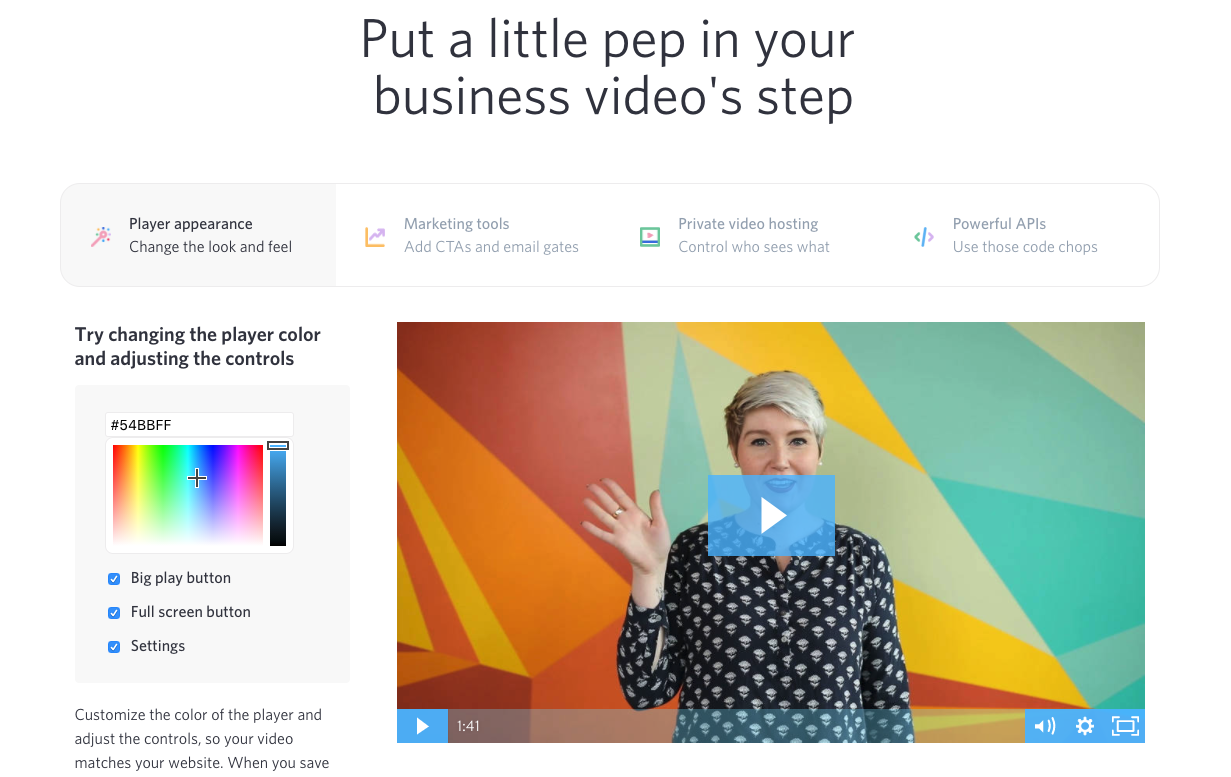
Others:
Website Analysis Tools
18. Above the Fold SEO Audit: Google scores your digital landscape according to SEO, mobile, social, usability, and many more. Knowing how you score is vital to your internet marketing effectiveness. We’ll deliver a full SEO audit of your website.
19. Website Grader: A great resource to receive immediate feedback on the strength and performance of your website, as well as tips on how to improve SEO, speed, security, and mobile performance.

20. Quicksprout: A full scope tool for website auditing, social media and competitor analysis.
Website Optimization
21. Hotjar: Heatmapping your website is an effective way to understand what users want, care about, and interact with on your website through visual representations of their clicks, taps, and scrolling behavior.
SEO
22. Open Site Explorer: Use Moz’s tool to determine your domain and page authority, incoming link sources, and a competition comparison. You can receive three free reports daily.
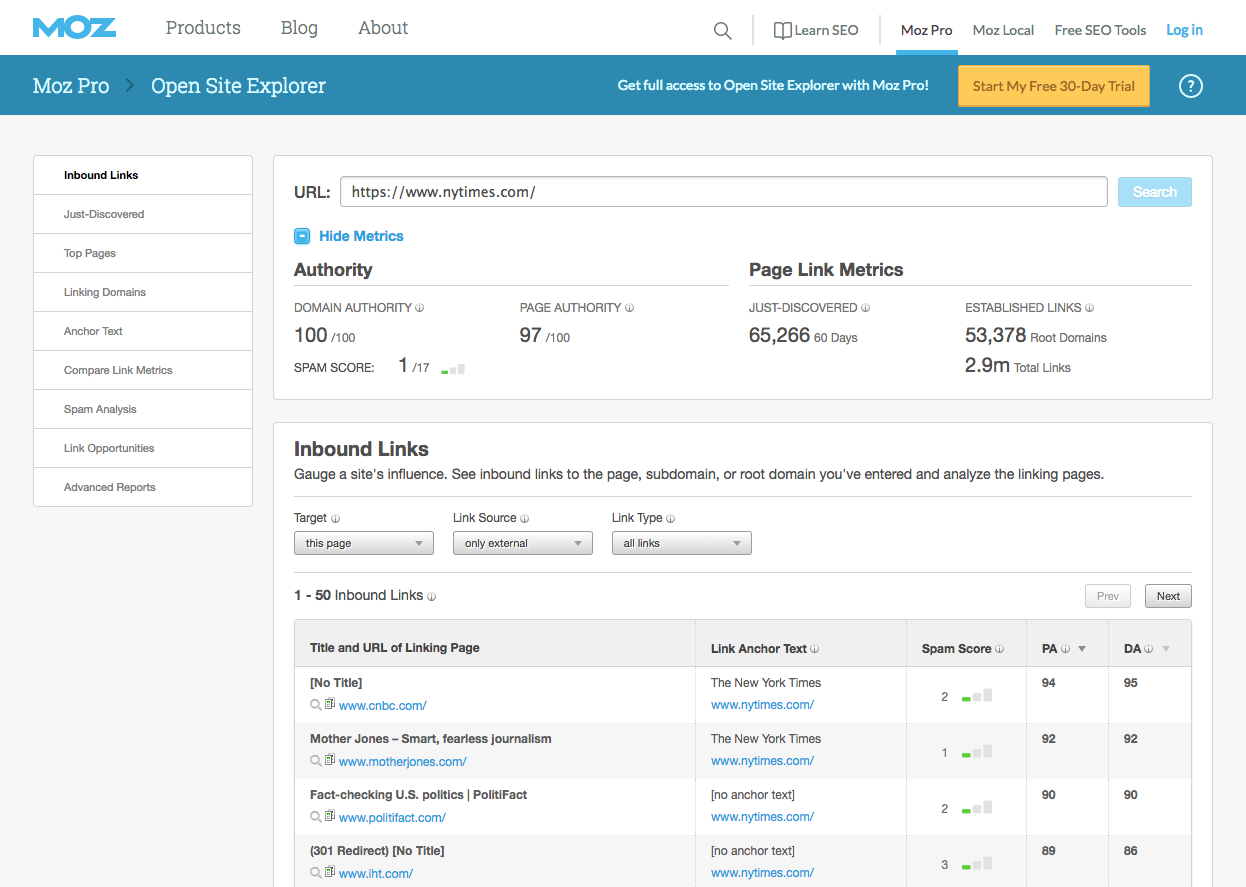
Other:
Email Marketing
23. Mailchimp: As an email marketing provider Mailchimp provides a very robust service. However, if you’re just starting to build your list and strategy their free option gives all the bells and whistles you’ll need.
If you have 2,000 subscribers, you can send up to 12,000 emails per month that comes with automation, sign up forms, modern templates, and data insight.
Project Management
24. Trello: Keep your team organized with Trello’s visual project management solution. With the ability to add team members, app integrations, comments, attachments, images, and set deadlines you’re able to keep every detail of a project in one place.

Other:
Communication
25. Slack: Eradicate the black hole that is searching through your email inbox with Slack. It’s an amazing internal company communication tool where you can message between employees, store information, upload attachments, and integrate other apps and tools you use daily. All done in a fun and modern way (with lots of emojis and gifs)!
CRM
26. Streak: For anyone looking to keep their CRM and email in one place should turn to Streak for Gmail. It’s an awesome and simple tool to manage and track current deals, especially if doing it on a smaller scale.

Lead Generation
27. SumoMe: They offer tools to automate site growth through non-intrusive pop ups where you can offer lead magnets to collect emails and social followers. The free version offers limited customization, however it’s a great place to start building your email lists.
Other:
